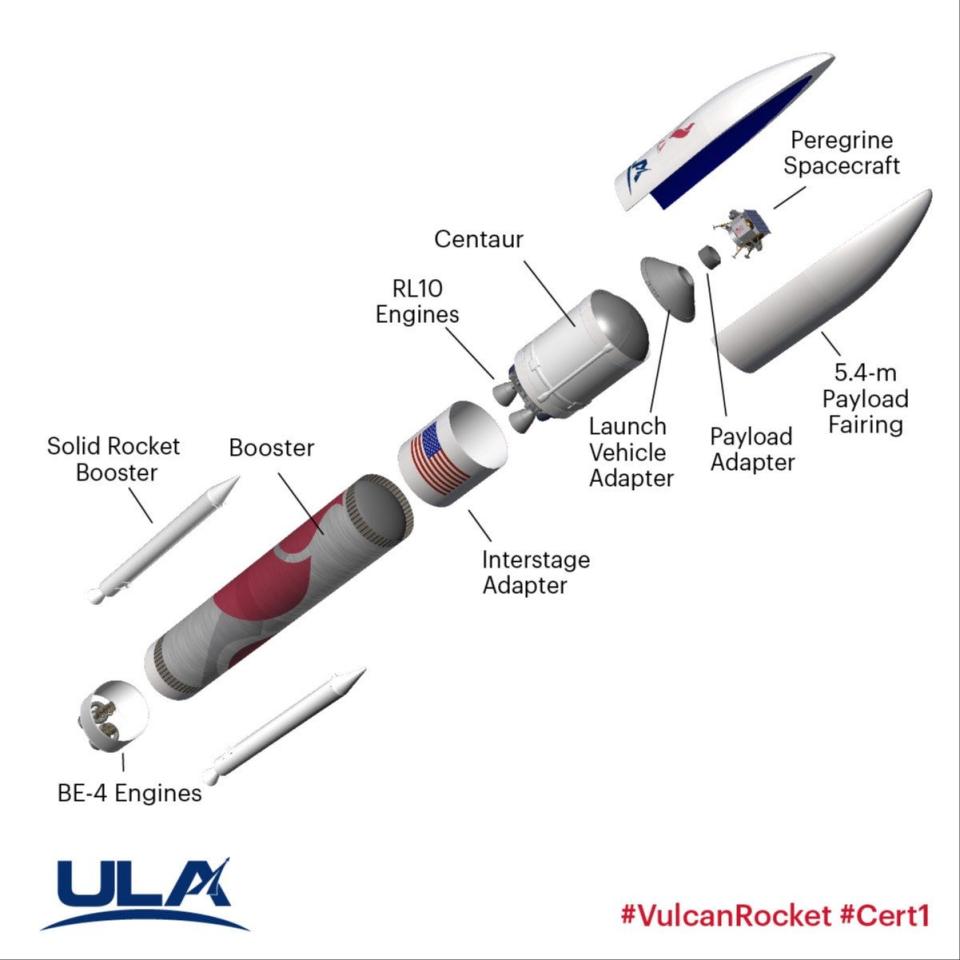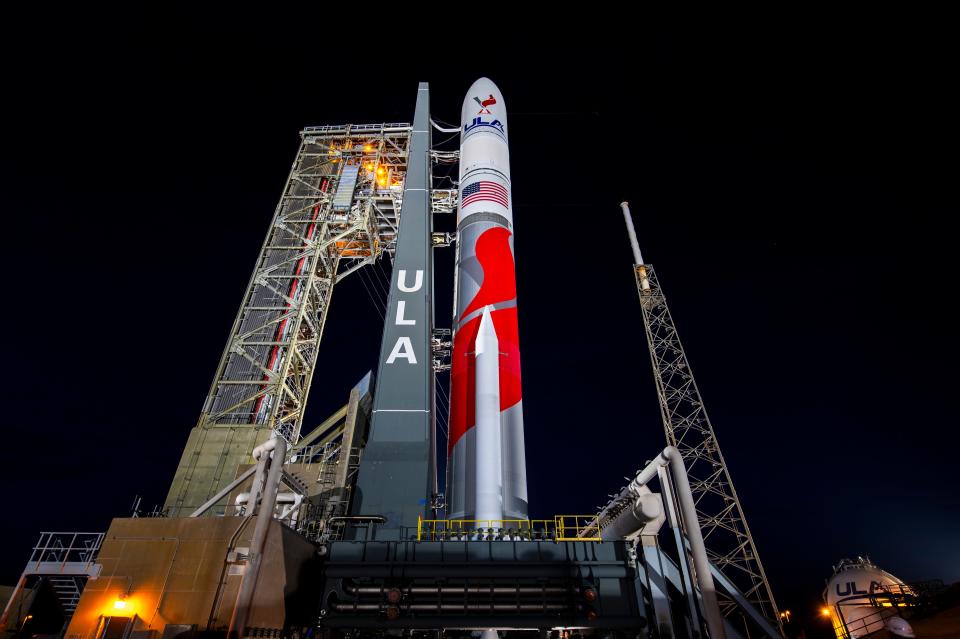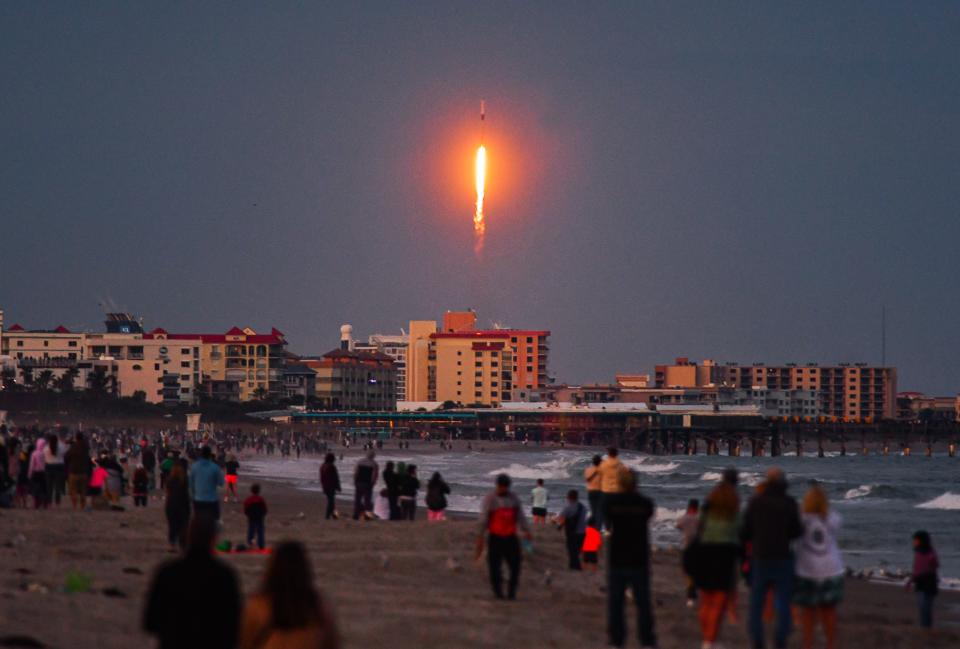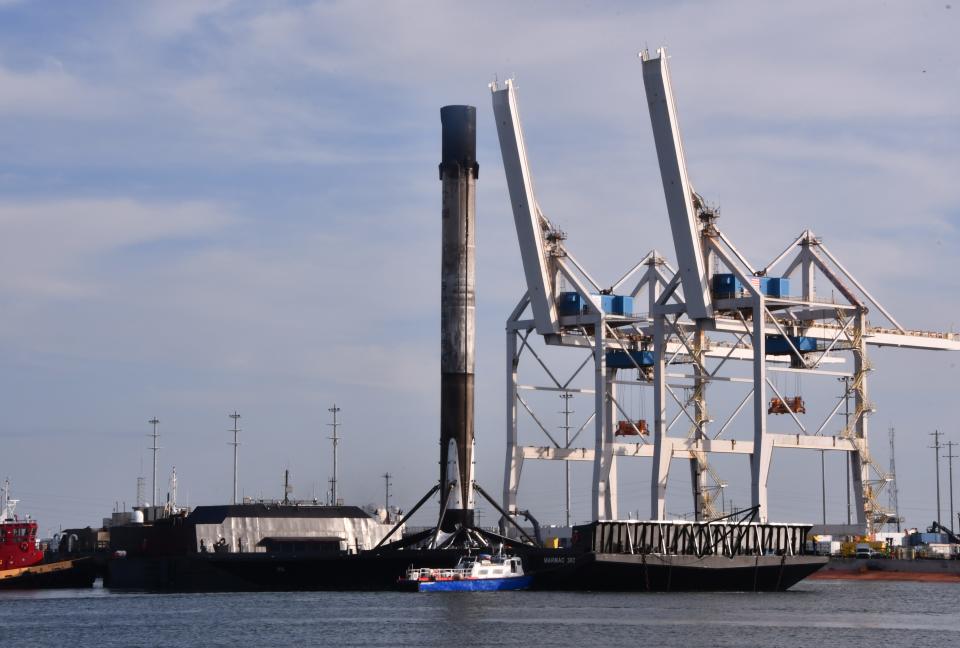Updates: ULA Vulcan, SpaceX Falcon 9 rocket launches on Jan. 7 and 8 from Cape Canaveral
Updates: Scroll down for live coverage of the 2:18 a.m. EST Monday, Jan. 8, liftoff of United Launch Alliance's Vulcan rocket on its Cert-1 maiden mission, preceded by the 5:35 p.m. Sunday, Jan. 7, liftoff of a SpaceX Falcon 9 rocket on the Starlink 6-35 mission.
Welcome to FLORIDA TODAY's Space Team live coverage of the history-making post-midnight Vulcan rocket launch from Cape Canaveral Space Force Station.
United Launch Alliance will send its next-generation Vulcan rocket on its Cert-1 maiden flight at 2:18 a.m. EST.
"Fueling operations are proceeding as planned at Space Launch Complex-41 to prepare Vulcan for its trek into interplanetary space," ULA officials announced at 10:18 p.m.
The Space Force's 45th Weather Squadron forecasts 85% favorable conditions for the Vulcan launch.
Kicking off a back-to-back launch doubleheader, SpaceX sent a Falcon 9 rocket into low-Earth orbit at 5:35 p.m. Sunday from nearby Launch Complex 40. The Falcon 9 deployed another batch of 23 Starlink internet satellites, which were packed inside the fairing halves atop the 230-foot rocket. Scroll down for updates from that Starlink 6-35 mission.
Check back for Vulcan updates on this page throughout the evening, increasing in frequency about 90 minutes before launch.
Liftoff!
Update 2:18 a.m.: ULA has just launched its first Vulcan rocket from Launch Complex 41 at Cape Canaveral Space Force Station.
LIFTOFF of United Launch Alliance's inaugural #VulcanRocket, America's new rocket that will unlock limitless possibilities in space. And the vehicle has cleared the tower! pic.twitter.com/H77yGt1QeY
— ULA (@ulalaunch) January 8, 2024
Final seven-minute countdown begins
Update 2:11 a.m.: The last seven minutes of tonight's Vulcan launch countdown have started, after a status-check poll of two dozen console operators and mission managers.
All polling is complete and launch team members, engineering specialists and leadership have unanimously voted GO to enter the final phase of the countdown. ULA Launch Director Tom Heter has given permission to launch #VulcanRocket #Cert1! pic.twitter.com/f4IcKLwOZW
— ULA (@ulalaunch) January 8, 2024
All good 14 minutes before Vulcan launch
Update 2:05 a.m.: The latest update from ULA:
"We are 14 minutes away from liftoff time of the Vulcan rocket.
"This is United Launch Alliance's 159th launch and the 21st in service to a commercial client. Today begins a new era for ULA as perform the inaugural flight of the versatile Vulcan," the update said.
Weather briefing: 'go for launch'
Update 1:54 a.m.: The Vulcan countdown's final planned briefing by weather officer Brian Belson has concluded with 'go for launch' conditions at Cape Canaveral.
"A series of weather balloons has been launched throughout the countdown from the Range weather station at the Cape to collect measurements of wind speeds and directions to determine if conditions aloft violate the controllability or structural loads on the rocket during ascent. The balloon data was transmitted to ULA engineers in Denver to select a steering profile that minimizes launch vehicle responses," according to a ULA launch update.
The launch weather officer says it looks like a good day for #VulcanRocket #Cert1 to go to space. Weather conditions at Cape Canaveral are observed and forecast go for the 2:18amEST (0718 UTC) liftoff time! https://t.co/xFQoT0042V pic.twitter.com/1bHeGydE5W
— ULA (@ulalaunch) January 8, 2024
Closer view of the Vulcan
Update 1:41 a.m.: Here's a ULA graphic that depicts the various components of the Vulcan rocket.

Vulcan countdown enters hourlong hold
Update 1:27 a.m.: A ULA countdown update posted at 1:18 a.m.: "We are exactly one hour away from liftoff of the inaugural Vulcan rocket for the Certification-1 mission. All activities are on track for a liftoff at 2:18:38 a.m. EST (0718:38 UTC)."
Another update: "The countdown has entered the planned 60-minute built-in hold designed to give a bit of margin to ensure we are ready for Terminal Count and today's launch window. During this pause, the final readiness polls of the launch team and management members will be performed."
Just more than 1 hour till Vulcan launch
Update 1:11 a.m.: ULA officials have tweeted out a nighttime photo of the Vulcan at the launch pad during the fueling process.
The spotlights are shining brightly on #VulcanRocket at Space Launch Complex-41 tonight as we count down to #Cert1, the flight test of our new high-performance rocket. pic.twitter.com/1afssgQy4y
— ULA (@ulalaunch) January 8, 2024
Vulcan launching Iris rover to the moon
Update 12:50 a.m.: Pittsburgh-based Astrobotic's robotic lunar lander, Peregrine, will land on the moon Feb. 23 and deploy Iris, a shoebox-sized mini-rover built by Carnegie Mellon University students.
"Over the course of 20 to 60 hours, Carnegie Mellon students of all backgrounds will work together to make live mission-critical decisions. The 2-kilogram rover will execute a series of linear and point turn movements, record images and data, and collaborate with other payloads to understand mobility, navigation and geoscience on the moon," an Iris promotional video said.
From the @cmu_iris payload team in their own words: the CMU student-built Iris Lunar Rover which will soon be headed to the Moon aboard Peregrine Mission One #PM1 pic.twitter.com/2LnrgRgz4U
— Astrobotic (@astrobotic) January 5, 2024
Vulcan: 'Green and GO across the board'
Update 12:26 a.m.: In a ULA launch update posted a few minutes ago, "a check of the local weather conditions shows green and GO across the board."
1/8/24 12:18 AM | We have activated our launch operations support team in preparation for the @ulalaunch Vulcan launch. Window: 2:18 - 3:04 AM pic.twitter.com/NKChwNWOmi
— Brevard EOC (@BrevardEOC) January 8, 2024
Where can you see the Vulcan launch?
Update 12:00 a.m.: On Friday, ULA officials tweeted this map that shows where spectators in Florida, Georgia and The Bahamas should be able to spot the Vulcan as it ascends into orbit.
Wondering if you can see the inaugural #VulcanRocket #Cert1 launch? This visibility map shows when and where your best chances are to see the rocket as it lifts off Monday at 2:18amEST (0718 UTC) from Cape Canaveral.
Launch info: https://t.co/xFQoT0042V pic.twitter.com/t5gofuof1B— ULA (@ulalaunch) January 5, 2024
Cape Canaveral seeing fair skies, gentle breeze
Update 11:24 p.m.: The National Weather Service reported fair skies, a temperature of 53 and north breeze of 5 mph as of 10:55 p.m. at Cape Canaveral Space Force Station.
The Space Force's 45th Weather Squadron forecast, which called for 85% odds of favorable Vulcan launch weather, listed thick cloud layers as the Cert-1 mission's primary meteorological risk.
"By the primary launch window, high pressure should bring generally favorable weather conditions although there is a slight chance of a Thick Cloud Layers Rule violation from clouds associated with the subtropical jet," the forecast said.
Looking up and into the bells of glory…. #VulcanRocket #FlameTrench pic.twitter.com/ZwvsbTBajl
— Tory Bruno (@torybruno) January 8, 2024
Launch Complex 41 history
Update 10:50 p.m.: As rocket fueling continues, ULA officials shared a variety of historical facts a few minutes ago detailing Launch Complex 41 at Cape Canaveral Space Force Station. Vulcan will mark the 110th flight from the facility:
"The pad was constructed by the U.S. Air Force in the 1960s for the Titan rocket program. There were 27 launches of the Titan family between 1965 and 1999, including NASA's two Viking missions in 1975 that landed on Mars and both Voyager probes to the outer solar system in 1977.
"The site was rejuvenated in support of the Atlas V starting in 1999. It employs a 'clean pad' concept of operations to ready launch vehicles and payloads for ascent into space. Construction to support Vulcan has occurred to transfer the site into a dual-use pad capable of supporting both rocket manifests simultaneously.
"The rocket elements are assembled atop a Vulcan Launch Platform inside the Vertical Integration Facility located adjacent to the launch pad. The platform and fully stacked Vulcan then travels by rail approximately 1,800 feet northward from the VIF to the pad for the final countdown, fueling and liftoff."
Coast Guard supporting Vulcan launch
Update 10:15 p.m.: The Port Canaveral-based U.S. Coast Guard cutter Skipjack, a 110-foot vessel designed for law enforcement operations, is staging to secure the Vulcan's offshore navigational warning zones.
The Space Launch Delta 45 rocket launch advisory shows the Vulcan will track essentially due east from the Cape, in contrast to the southeasterly trajectory traveled by today's SpaceX Falcon 9 on the Starlink 6-35 mission.
The @USCG Cutter Skipjack crew is offshore Cape Canaveral staging to support the @ulalaunch Vulcan launch overnight. All mariners are advised to remain clear of the Security Zone, Regulated Navigation Area, and special hazard area. https://t.co/Wd8LHJJtDK pic.twitter.com/px870g1PXv
— USCGSoutheast (@USCGSoutheast) January 8, 2024
ULA Vulcan: 'No significant issues' thus far

Update 9:43 p.m.: In a series of updates, ULA officials are describing the ongoing rocket-fueling process. The following post provides a synopsis:
"This is Vulcan Launch Control as we enter the final five hours until liftoff of the inaugural flight of United Launch Alliance's new rocket. We are loading liquid oxygen into the Centaur V upper stage and active with preps on the other three commodities for tanking the launch vehicle tonight," the post said.
"No significant issues are being addressed in the countdown and weather conditions remain in our favor for launch at 2:18 a.m. EST (0718 UTC) from Space Launch Complex-41 at Cape Canaveral Space Force Station in Florida."
Vulcan liquid-oxygen fueling begins
Update 9:13 p.m.: From ULA: "With the thermal conditioning, or chilldown, now complete, liquid oxygen has started to flow into the Centaur V upper stage for today's launch.
"For this 271st flight of Centaur, the upper stage will perform three burns during launch to achieve a parking orbit, a high-energy transfer orbit for Peregrine and an Earth-escape trajectory into deep space for the non-deployable Celestis memorial payload."
Tonight's launch countdown resumed on schedule about a half hour ago.
Check out SpaceX Falcon 9 gallery
Update 9:01 p.m.: Here is FLORIDA TODAY's 16-image photo gallery of today's SpaceX Falcon 9 launch from Cape Canaveral Space Station.
Vulcan countdown enters 1st of 2 holds
Update 8:28 p.m.: ULA officials just announced that the Vulcan countdown has entered the first of two planned holds.
As a reminder, here is what Gary Wentz, ULA vice president of government and commercial programs, said during a Friday pre-launch press conference:
"We'll complete some of the initial preparations and then clear the launch complex at L-minus-6 hours. At L-minus-5½ hours, we will start the chill-down in preparation for cryogenic tanking. And that'll conclude with a complete tanking around L-minus-2 hours," Wentz said.
The first countdown hold "ensures all steps in the procedure prior to cryogenic propellant loading are complete and satisfactory before the start of tanking," a ULA blog post said.
The countdown has entered the first of two planned holds. This block of time ensures all steps in the procedure prior to cryogenic propellant loading are complete and satisfactory before the start of #VulcanRocket tanking. Weather is GO for fueling and remains 85% GO for launch. pic.twitter.com/TfvsiPL3hY
— ULA (@ulalaunch) January 8, 2024
ULA: 'Teams are working no issues'
Update 6:27 p.m.: New tweet from ULA: "The #VulcanRocket countdown is proceeding on pace. Final system preps and testing procedures are underway as we continue to target liftoff at 2:18amEST (0718 UTC) to put @Astrobotic's Peregrine lunar lander on its course to the Moon. Teams are working no issues."
The #VulcanRocket countdown is proceeding on pace. Final system preps and testing procedures are underway as we continue to target liftoff at 2:18amEST (0718 UTC) to put @Astrobotics's Peregrine lunar lander on its course to the Moon. Teams are working no issues. pic.twitter.com/uwNrF98iob
— ULA (@ulalaunch) January 7, 2024
SpaceX rocket photographed from Cocoa Beach
Update 6:11 p.m.: FLORIDA TODAY Photographer Malcolm Denemark snapped this image of the SpaceX Falcon 9 rocket ascending in the sky, seen from Cocoa Beach with Lori Wilson Park launch spectators in the foreground.

SpaceX Falcon 9 booster lands
Update 5:44 p.m.: The Falcon 9 first-stage booster has landed aboard SpaceX's drone ship A Shortfall of Gravitas out on the Atlantic Ocean, completing its 16th mission.
Falcon 9’s first stage has landed on the A Shortfall of Gravitas droneship pic.twitter.com/VyAT1NMfAD
— SpaceX (@SpaceX) January 7, 2024
Liftoff!
Update 5:35 p.m.: SpaceX has just launched a Falcon 9 rocket carrying 23 Starlink satellites from Launch Complex 40 at Cape Canaveral Space Force Station.
Liftoff! pic.twitter.com/4zZSL9dGFz
— SpaceX (@SpaceX) January 7, 2024
SpaceX Starlink launch webcast begins
Update 5:30 p.m.: SpaceX's live launch webcast has just begun on X (formerly Twitter).
Liftoff is scheduled in five minutes from Cape Canaveral Space Force Station.
Watch Falcon 9 launch 23 @Starlink satellites to orbit https://t.co/3pTEVxt5ZI
— SpaceX (@SpaceX) January 7, 2024
ULA Vulcan countdown still on schedule
Update 5:22 p.m.: Tweet from ULA: "#VulcanRocket #Cert1 countdown activities are on schedule for tonight's liftoff. The rocket is powered up and ULA engineering teams at the Cape Canaveral launch site and Denver headquarters are not working any issues that would preclude liftoff at 2:18amEST."
#VulcanRocket #Cert1 countdown activities are on schedule for tonight's liftoff. The rocket is powered up and ULA engineering teams at the Cape Canaveral launch site and Denver headquarters are not working any issues that would preclude liftoff at 2:18amEST (0718 UTC). pic.twitter.com/aNvqF37EkS
— ULA (@ulalaunch) January 7, 2024
SpaceX booster to land on drone ship

Update 5:15 p.m.: Tonight's mission marks the 16th flight for this Falcon 9 first-stage booster, SpaceX reports.
After stage separation, the booster is slated to land on the drone ship A Shortfall of Gravitas out on the Atlantic Ocean 8 minutes, 27 seconds after liftoff.
The booster previously launched CRS-22, Crew-3, Turksat 5B, Crew-4, CRS-25, Eutelsat HOTBIRD 13G, mPOWER-a, PSN SATRIA and seven Starlink missions, SpaceX reported.
SpaceX Falcon 9 fueling is now underway
Update 5:06 p.m.: Falcon 9 fueling procedures are now underway at Launch Complex 40.
"Less than one hour until today's launch of 23 @Starlink satellites from Florida, all systems are looking good and weather is 95% go," SpaceX officials announced in a tweet.
Tonight’s Starlink 6-34 mission is now committed to lift off at 5:35 p.m., or else the launch must be postponed.
1/7/24 4:27 PM | We have activated our launch operations support team in preparation for the SpaceX Falcon9 launch. Window: 5:25 - 8:00 PM pic.twitter.com/bfSNGGAR0I
— Brevard EOC (@BrevardEOC) January 7, 2024
ULA starts Vulcan launch countdown
Update 4:39 p.m.: The countdown is underway for the upcoming 2:18 a.m. maiden launch of the Vulcan rocket, ULA officials announced in a tweet.
"We'll be applying vehicle power around 3 p.m. on Sunday. That's at launch-minus-11 hours," Gary Wentz, ULA vice president of government and commercial programs, said during a Friday pre-launch press conference.
"We'll complete some of the initial preparations and then clear the launch complex at L-minus-6 hours. At L-minus-5½ hours, we will start the chill-down in preparation for cryogenic tanking. And that'll conclude with a complete tanking around L-minus-2 hours," Wentz said.
There is anticipation in the air as we officially begin the countdown for tonight's historic inaugural launch of the #VulcanRocket #Cert1 mission. Launch time is 2:18amEST (0718 UTC) from Cape Canaveral. https://t.co/xFQoT0042V pic.twitter.com/yA7GjM5rZ8
— ULA (@ulalaunch) January 7, 2024
SpaceX launch forecast: 80% 'go'
Update 4:20 p.m.: The Space Force's 45th Weather Squadron forecasts 80% favorable conditions for the upcoming SpaceX launch. More details:
"Showers and a few embedded thunderstorms associated with a slow-moving cold front will move across central Florida today, likely ending by mid-to-late afternoon," the squadron's forecast said.
"The front is forecast to settle just south of the area tonight into early tomorrow, but additional energy riding up along the boundary may induce extensive cloud cover and a few showers early Sunday across the Spaceport," the forecast said.
For the latest launch schedule updates from Cape Canaveral Space Force Station and NASA's Kennedy Space Center, visit floridatoday.com/launchschedule.
Rick Neale is a Space Reporter at FLORIDA TODAY (for more of his stories, click here.) Contact Neale at 321-242-3638 or rneale@floridatoday.com. Twitter/X: @RickNeale1
This article originally appeared on Florida Today: ULA Vulcan historic launch: Live updates from Cape Canaveral, Florida

